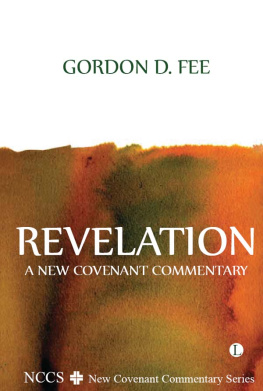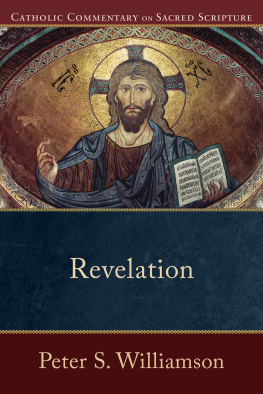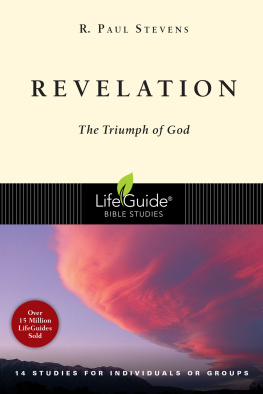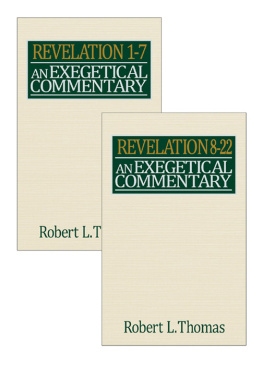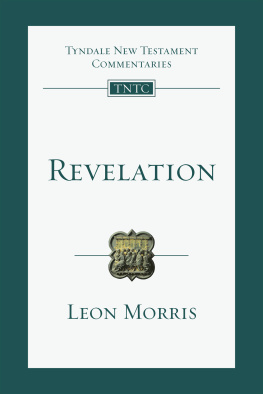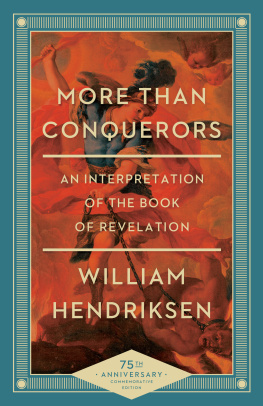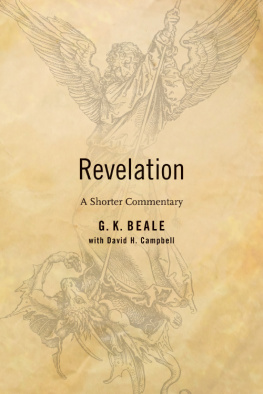REVELATION
REVELATION
A New Covenant Commentary
GORDON D. FEE

The Lutterworth Press
The Lutterworth Press
P.O. Box 60
Cambridge
CB1 2NT
United Kingdom
www.lutterworth.com
publishing@lutterworth.com
ISBN: 978 0 7188 4335 9
British Library Cataloguing in Publication Data
A record is available from the British Library
Copyright Gordon D. Fee, 2011
First published by The Lutterworth Press, 2013
Published by arrangement with Cascade Books,
a division of Wipf and Stock Publishers
All rights reserved. No part of this edition may be reproduced, stored
electronically or in any retrieval system, or transmitted in any form
or by any means, electronic, mechanical, photocopying, recording,
or otherwise, without prior written permission from the
Publisher (permissions@lutterworth.com).
Contents
Outline of Revelation
The (Original) Tale of Two Cities, Part 1:
The Demise of Rome (17:119:10)
The (Original) Tale of Two Cities, Part 2:
God Makes All Things New (Revelation 21:122:5)
Stepping into the Revelation from the rest of the New Testament is to enter into a strange, bizarre new world; and this is true even in the days of Lord of the Rings and Harry Potter. Instead of narratives, arguments, or plain statements of fact, the Revelation is full of angels, trumpets, and earthquakes; of strange beasts, dragons, and bottomless pits. Most believers, therefore, take one of two extremes: some simply avoid it in despair; others take an exaggerated interest in it, thinking to find here all the keys to the end of the world.
Both of these positions, I would argue, are simply wrong. On the one hand, in the providence of God it is Holy Scripture, a part of the twenty-seven-document canon of the New Testament. Indeed, it serves as the ultimateand marvelousconclusion to the whole of Scripture. On the other hand, a great deal of what has been written about it, especially at the popular level, tends to obscure its meaning rather than to help the reader understand it. In fact many years ago, when I was teaching a course on the Revelation at Wheaton College, one of the options for a term paper was to analyze the exegesis of Hal Lindsays The Late Great Planet Earth. Two students took me up on this alternative, both of whom independently came to the conclusion that the task was altogether impossible, since there is not a single exegetical moment in Lindsays entire book. John himself would surely have found Lindsays book as apocalyptic as most modern readers do Johns.
The purpose of the present book is therefore singular: to offer one New Testament scholars exegetical reading of the text, with very little concern for anything except to help people hear it for the word of God that it is. And therefore none of the so-called alternative ways of understanding the book will hereafter be mentioned in this book. At the same time, I would be deceiving the reader if I did not admit that I am equally concerned that the exegesis leads to theological understanding. That is, what does it mean for God and his Christ to be the one and only sovereign(s) in a universe in which others compete for sovereignty and worship; and what does it mean for contemporary people of God to be a countercultural alternative in such a world, just as John himself was, and was encouraging his readers to be? Furthermore, with theology there must be worship, because whatever else is true about this marvelous Revelation, John recognizes that truly Christian theology should lead to doxology. That is, descriptions of God that do not lead to the worship of God might be intellectually useful, but they are unrelated to biblical reality; and biblical reality is what John wants his readers to see and hear. In a form of divine sovereignty that often accompanies biblical prophecy, John wrote what turned out to be the final book in the Christian canon; and thus it serves fittingly as the climax to both the New Testament and to the entire biblical storywhich begins in Eden and concludes with a restored Eden.
Finally, I should note that the biblical text used throughout is the (yet to be published) 2011 edition of the NIV, which has been used by permission of the Committee on Bible Translation who are responsible for the translation (to which I have access before publication as a member of the translation committee) and of the Zondervan Corporation who will publish it.
Gordon D. Fee
October 2009
The purpose of this introduction is twofold: to introduce the reader both to the Book of Revelation and to this commentary on the book. We begin with the former. At issue is the fourfold question of what, why, who, and when.
THE REVELATION: WHAT IS IT?
Readers of the New Testament experience something of a shock when they come to the book of Revelationat least once they get past the first five chapters, which are quite manageable. Even the two scenes in heaven in chapters 4 and 5which may be a bit different, to be sureare still manageable. At chapter 6, however, with its four colored horses, souls under the altar, and great earthquake, everything changes. At this point most contemporary readers have a sense of being thrown into a strange new world, and those who from a sense of duty keep on reading to the end find themselves in a constant struggle to stay with it. It is not difficult to understand horses or beasts as such, but colored horses and beasts with seven heads and ten horns do stretch the imaginationespecially so for those who draw mental pictures as they read.
So the first task for any reader of a book is to understand (or at least anticipate) the kind of literary genre of the writing; and that is where in this case everything tends to break down. People understand what letters are, and how they function, and so have access to the New Testament Epistles. For the most part they are also able to recognize the style and poetry of the Old Testament Prophetsalthough with a degree of difficulty at times, to be sure. Thus the images themselves for the most part lie within the worldview of the reader, and that because the images are expressions of reality. But with Jewish apocalyptic writings (Daniel 711 and much of Ezekiel) all of that changes, since many of the images are intentionally bizarre and thus their meaning is uncertain.
What one must understand before reading Johns Revelation is that he has purposely set out to write something that has not been done before, something that he sets up his readers to understand at the very beginning. Thus in 1:1 he identifies what he is about to write as an apocalypse, translated revelation in the NIV, which in 1:3 he refers to as a prophecy. But in the next two verses he begins again with all the formal aspects of an ancient letter. So the reader is given these three different pieces of information at the outset. What is unique about Johns Apocalypse is the fine blending of each of these three kinds of literatureapocalypse, prophecy, letterinto a single whole piece.
We begin, then, with the Revelation as an apocalypse, a word used to describe a kind of literature that flourished first among Jews and then Christians for roughly the four-hundred-year period between 200 BCE and 200 CE, although its roots lie much earlier. The taproot of apocalyptic was deeply embedded in the Old Testament Prophets, which means that whatever else, these writers, including John, were concerned about judgment and salvation. But the prophets, in contrast to the apocalyptists, were not primarily

